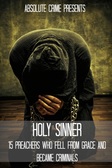Holy Sinner: 15 Preachers Who Fell From Grace and Became Criminals

Preachers, like the rest of us, are flawed humans who often fall from grace; but when a preacher falls, it tends to echo a lot louder. For the 15 preachers profiled in this anthology, they didn’t just sin—they became criminals.
Buy Now!
Holy Sinner PDF and ePub |
Excerpt
Origins
In 1620 Thomas Weston revolutionized American society forever by inventing the all-American, all-religious swindle. Weston, dissatisfied with a livable but limited smuggling operation, moved to expand his horizons into the nation-building game. His agent in the Netherlands, Edward Pickering, happened to have married into a devout little expatriate community of puritans who had escaped England and its decadent observation of Christmas and Weston saw in this nervous little community an opportunity. He promised them an unconditional colonial charter in Massachusetts where they could persecute Quakers and not celebrate Christmas all year round and, in an early foreshadowing of New World ingenuity, he was lying.
The new community of Plymouth had unknowingly signed on to overpay for their non-existent charter and fetid, frigid and often fatal sea-voyage on the Mayflower and subsequent abandonment on a barren rock in the middle of a winter that would wipe out half of them before Spring. Then the survivors could start their six-day workweek knocking a hole in a debt that would be entirely paid off in 28 short years. Weston quit the community in 1622, though, to pursue an interest in poisoning relations with Native Americans and selling stolen canons to Turkish pirates.
But the community persisted as puritans so often will and became the backbone of American religious life: the patsy. Soon they were joined by immigrants from other parts of Europe, who brought their mysterious and exotic approaches to worship involving incense and singing songs and priests with pointy hats along with them. There was either going to be a full-hearted accommodation of these mysterious strangers or there was going to be trouble.
So there was trouble. Religious freedom at the time meant the freedom to abuse the freedom of others, but the New World offered the differing factions a uniquely American peacemaker they couldn’t have at home: distance. The Quakers put some honest shoe leather between themselves and Puritan Massachusetts and moved to Pennsylvania. The Church of England parishioners made their home in Virginia while the Catholics, dreaming of bonny, rainy Ireland, chose Maryland.
And it was good. This enormous experiment in religious tolerance was working and it ingrained into the national subconscious a fervent love of liberty, religious and otherwise. The Puritans didn’t mind the Quakers putting trees in their living rooms so long as they were free to wear three layers of black wool on the hottest summer days. Anglican ministers could be married and Catholic priests could not. But ire has to go somewhere, of course, so they aimed it at England and pulled the trigger and when the smoke cleared America was its own country of hard-won polygamy and piousness and pointy hats.
Now that America had rid itself of the tyranny of the crown and the outrageous taxes on tea, her churches began to lose interest in what Rome or Canterbury had to say and salvation became a buyer’s market. Soon enough Anglican Church dissenters begat the Episcopalians and the Baptists which split again into the First Baptists and the Southern Baptists and, in union with the Presbyterians and the Methodists, the Church of Christ. The Calvinists of the New World mutated into Mennonites and some disenfranchised Methodists became the Holiness Churches and The Churches of God of Indiana and Tennessee while others enlisted in the Salvation Army. When William Miller’s prediction of the second coming turned out to have skipped a decimal place his flock of former Baptists and Methodists and Presbyterians expressed their disappointment by forming the Seventh Day Adventists and observing the Sabbath on Saturdays and maintaining that Christ would be along any minute now.
It was in this freewheeling environment that the revival tent began its golden age and anyone with a talent for oratory, driving out demons, making it rain, or looking sincere in a white linen suit could make a living delivering the Good News. Inevitably among these millennialists, cessationists, charismatics, prophets, faith healers, snake-handlers and speakers-in-tongues, there were bound to be one or two bad apples.
Which brings us to this book. America’s passion for liberty is fertile ground for con men, charlatans and all manner of successor to the innovative Thomas Weston. We’ll have a look at some of the more colorful stories of the sexual deviants, porn stars, murderers and baby-snatchers who populate the dark side of evangelism. Compared to some of them, Thomas Weston looks like a kinder, gentler St. Francis of Assisi.
In 1620 Thomas Weston revolutionized American society forever by inventing the all-American, all-religious swindle. Weston, dissatisfied with a livable but limited smuggling operation, moved to expand his horizons into the nation-building game. His agent in the Netherlands, Edward Pickering, happened to have married into a devout little expatriate community of puritans who had escaped England and its decadent observation of Christmas and Weston saw in this nervous little community an opportunity. He promised them an unconditional colonial charter in Massachusetts where they could persecute Quakers and not celebrate Christmas all year round and, in an early foreshadowing of New World ingenuity, he was lying.
The new community of Plymouth had unknowingly signed on to overpay for their non-existent charter and fetid, frigid and often fatal sea-voyage on the Mayflower and subsequent abandonment on a barren rock in the middle of a winter that would wipe out half of them before Spring. Then the survivors could start their six-day workweek knocking a hole in a debt that would be entirely paid off in 28 short years. Weston quit the community in 1622, though, to pursue an interest in poisoning relations with Native Americans and selling stolen canons to Turkish pirates.
But the community persisted as puritans so often will and became the backbone of American religious life: the patsy. Soon they were joined by immigrants from other parts of Europe, who brought their mysterious and exotic approaches to worship involving incense and singing songs and priests with pointy hats along with them. There was either going to be a full-hearted accommodation of these mysterious strangers or there was going to be trouble.
So there was trouble. Religious freedom at the time meant the freedom to abuse the freedom of others, but the New World offered the differing factions a uniquely American peacemaker they couldn’t have at home: distance. The Quakers put some honest shoe leather between themselves and Puritan Massachusetts and moved to Pennsylvania. The Church of England parishioners made their home in Virginia while the Catholics, dreaming of bonny, rainy Ireland, chose Maryland.
And it was good. This enormous experiment in religious tolerance was working and it ingrained into the national subconscious a fervent love of liberty, religious and otherwise. The Puritans didn’t mind the Quakers putting trees in their living rooms so long as they were free to wear three layers of black wool on the hottest summer days. Anglican ministers could be married and Catholic priests could not. But ire has to go somewhere, of course, so they aimed it at England and pulled the trigger and when the smoke cleared America was its own country of hard-won polygamy and piousness and pointy hats.
Now that America had rid itself of the tyranny of the crown and the outrageous taxes on tea, her churches began to lose interest in what Rome or Canterbury had to say and salvation became a buyer’s market. Soon enough Anglican Church dissenters begat the Episcopalians and the Baptists which split again into the First Baptists and the Southern Baptists and, in union with the Presbyterians and the Methodists, the Church of Christ. The Calvinists of the New World mutated into Mennonites and some disenfranchised Methodists became the Holiness Churches and The Churches of God of Indiana and Tennessee while others enlisted in the Salvation Army. When William Miller’s prediction of the second coming turned out to have skipped a decimal place his flock of former Baptists and Methodists and Presbyterians expressed their disappointment by forming the Seventh Day Adventists and observing the Sabbath on Saturdays and maintaining that Christ would be along any minute now.
It was in this freewheeling environment that the revival tent began its golden age and anyone with a talent for oratory, driving out demons, making it rain, or looking sincere in a white linen suit could make a living delivering the Good News. Inevitably among these millennialists, cessationists, charismatics, prophets, faith healers, snake-handlers and speakers-in-tongues, there were bound to be one or two bad apples.
Which brings us to this book. America’s passion for liberty is fertile ground for con men, charlatans and all manner of successor to the innovative Thomas Weston. We’ll have a look at some of the more colorful stories of the sexual deviants, porn stars, murderers and baby-snatchers who populate the dark side of evangelism. Compared to some of them, Thomas Weston looks like a kinder, gentler St. Francis of Assisi.








